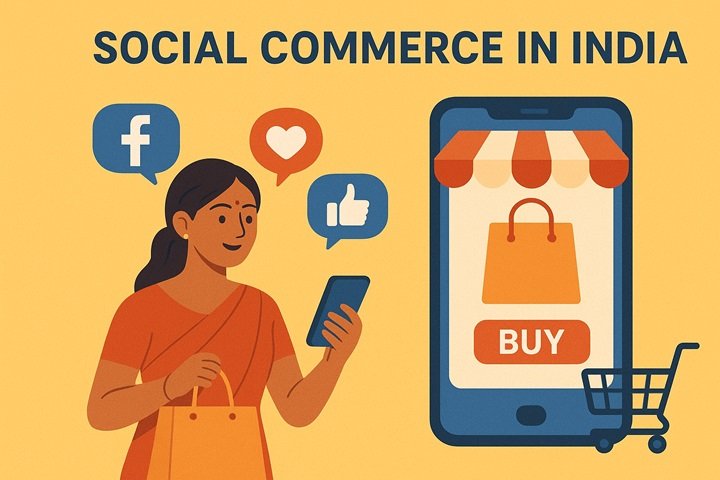
Social Commerce in India: Redefining how people shop online
Imagine you are scrolling through your phone. You see a video that pops up, talking about a particular product, a video tutorial, or an unboxing video, and this captures your attention and without leaving the app you click on buy. This instant and seamless transition from discovering a product and purchasing the product via social media platform is what social commerce is all about.
In other words, social commerce is using social media platforms to enable the buying and selling of products, by integrating the shopping experience directly into the social media environment.
In India, social commerce is rapidly growing and is revolutionizing the way people shop online by blending social media with e-commerce . India is a key market for social commerce because of its high internet penetration and massive social media user base.
According to IMARC, the Indian Social commerce market size was valued at USD 7.2 billion in 2024 and the market is expected to reach USD 54.3 billion by 2033, and is exhibiting a CAGR of 22.40% during 2025-2033.
In India, social commerce is widely used by the Gen Z and millennials, they are the driving force behind the growth of social commerce, especially within the fashion and beauty categories. The in-demand categories for social commerce in the retail and e-commerce sectors are, clothing, footwear, beauty and personal care, and food and grocery.
In the Indian social commerce realm, platforms like Meesho, Shopsy and Deal Share are leading the charge. Alongside well-known players like Amazon and Flipkart. The other key players are, Trell, Roposo, Moj, and Myntra. For instance, Myntra has integrated a social a social commerce feature like ‘Style Squad’ to leverage influencer marketing.
These developments reflect a broader shift in how commerce is evolving, by blending social interaction with online shopping. But how exactly does social commerce work?
First, the consumer discovers products through various social media channels, advertisements, influencer endorsements, brand posts and live streams. Social commerce has made the shopping experience seamless, and consumers can make the purchase directly within the social media platform, usually through integrated shopping carts and payment gateways. It also fosters a sense of community by allowing users to interact with brands share their experience, and connect with fellow shoppers. This in turn creates a sense of trust and belonging. This paired with personalised product recommendations and targeted advertising, caters to the moder consumers preference for convenience and tailored experiences.
This customer centric evolution of shopping not only enhances the buyers experience but also opens the door for business opportunities, especially in a diverse and rapidly digitised market like India.
In India, social commerce is greatly helping retail and e-commerce businesses, by expanding their reach, boosting customer engagement, and driving sales. By taking advantage of social media platforms, companies are able to connect with a broader audience, fostering customer relationships which directly facilitates direct purchases within the platform itself. On that note, social commerce will only work where the social media usage is high and platforms like Facebook and Instagram are well known for shopping.
As digital adoption continues to rise and consumer behaviour evolves, the future of social commerce in India looks promising.
The social commerce space is expected to change course from basic reselling and social selling to a more sophisticated, AI powered retail channel. Major trends include, the rise of full stack commerce within platforms like Whats App and You Tube, the rise in short form videos which engage consumers, advanced customer profiling to deliver hyper-personalised experiences and the integration of AR/VR technologies for immersive shopping.
In Conclusion, Social commerce is changing the way people shop in India by making online shopping more social and interactive. With more people online than ever before, especially younger, tech-savvy shoppers, its helping businesses reach more customers and create stronger connections. New technologies like AI, short videos, and virtual reality are making the experience even more engaging and fun. As people look for easier, more personalized ways to shop, social commerce is set to become a big part of India’s online shopping future, opening up exciting opportunities for both companies and customers.






